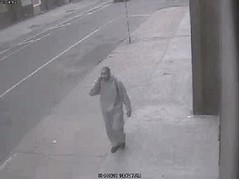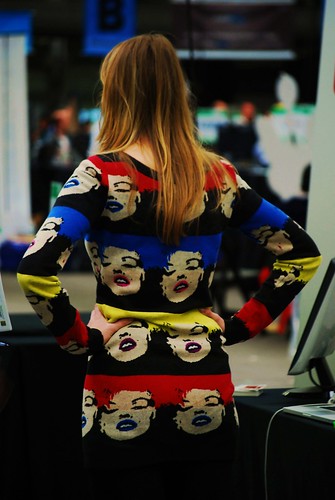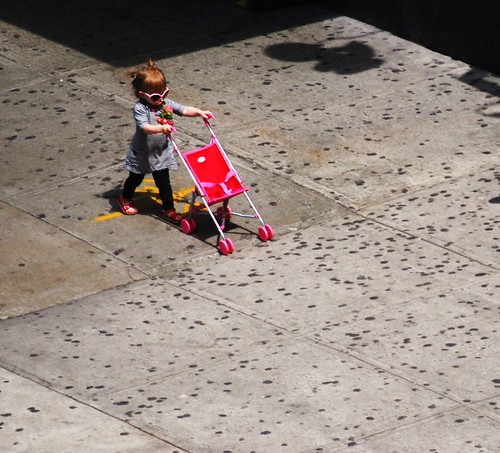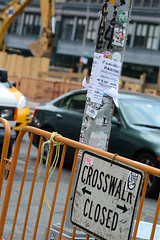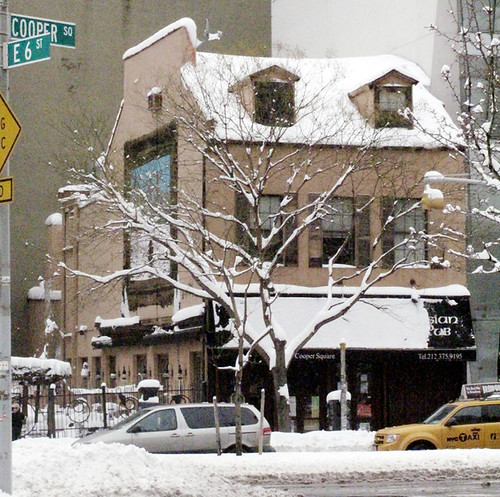 The police say that this man is a suspect in five robberies.
The police say that this man is a suspect in five robberies.The authorities are looking for a man suspected of committing five robberies — including three in the East Village — over the course of four days.
The first incident occurred on May 12 at 315 East 18th Street, when the thief approached a 26-year-old woman at around 10:30 p.m., brandished a knife and demanded her wallet. He fled the scene empty-handed.
The next morning the suspect struck again, this time in our neighborhood at Second Avenue and East Houston Street. The police said he grabbed a 27-year-old woman from behind, covered her mouth and once again failed to steal his victim’s wallet.
Investigators said that on May 14, the suspect struck twice more in the East Village. At 1:20 a.m. he wrapped his arm around a woman’s neck at 202 East Sixth Street and stole her cell phone. Then, the police said that at 9:10 a.m. the man covered another woman’s mouth at Lafayette and Bleecker Streets and demanded her wallet. He again left empty-handed.
In the fifth incident, the police said that the man pushed a 24-year-old woman against a wall at 44 Wall Street at 3 a.m. and stole her cell phone.
Police said the man — who is pictured above in a pair images from surveillance cameras — is roughly 6 feet tall and weighs about 200 pounds.
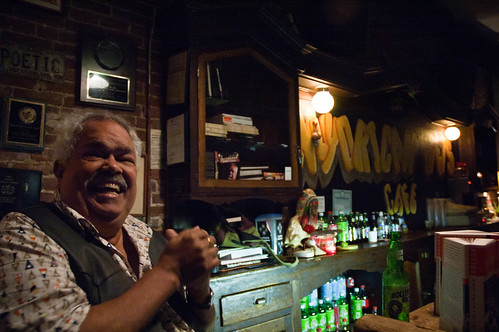 Hannah ThonetThe poet Miguel Algarín.
Hannah ThonetThe poet Miguel Algarín.Good morning, East Village.
The founder of Nuyorican Poets Cafe, Miguel Algarín, is fighting for his legacy. According to Sonic Scoop, the 69-year-old poet and former Rutgers University professor, who spent years bringing the work of new poets into the public eye, will be the subject of a documentary. “The Miguel Algarin Story,” which is still in production, depicts the poet’s life, his early achievements, his challenges with HIV, but mainly targets the ongoing struggle he faces in trying to reclaim a leadership role at his landmark club.
While condo sales in the Village continue to log seven-figure milestones, Downtown Express offers a look back to the vacant properties along 13th Street during the early 1990’s and the street art of the squatter movement. For more artifacts of the squatter’s life visit The Times’ coverage of the 2010 exhibition, “The Perfect Crime,” at Bullet Space.
And finally, Ephemeral New York shares a serene noir view of the city via a 1928 etching by the artist Martin Lewis, which depicts a man peering over a railing on the Williamsburg Bridge.
 Phillip Kalantzis Cope
Phillip Kalantzis CopeYesterday, we told you about a post by the Neither More Nor Less blog that marked the 20th anniversary of the 1991 Memorial Day riot in Tompkins Square Park.
Bob Arihood, the author of Neither More Nor Less, correctly noted that we erred in indicating that the riot was sparked because of the park’s homeless population.
“This riot was not about a homeless encampment in Tompkins Square Park . It was the result of the enforcement of the ending time of a concert . the concert goers were mostly drunk . bottles had been stashed in preparation for a riot . Cops and drunks confronted each other and nature took its course”
And longtime resident Martin Johnson offered his recollection of the evening.
“The street and sidewalks were cluttered with the debris of a riot, and police with combat gear were everywhere. When I reached 9th St, a policeman stopped me and asked me where I thought I was going. I told him “home,” and that I lived on Avenue A near 14th. He asked if I had some ID or a utility bill to prove it. My Driver’s License uses my mailing address, so I told him I didn’t have anything other than my word (which had usually been good enough). He threw me against the side of the building which now houses Cafe Pick Me Up and told me I was lying and that if I didn’t get off of *his* block, he was going to shove his nightstick down my throat.
You can read Mr. Johnson’s complete account of the night here.
Join the conversation: Do you have any memories of the riot on Memorial Day 1991? Please share them in the comments section below.
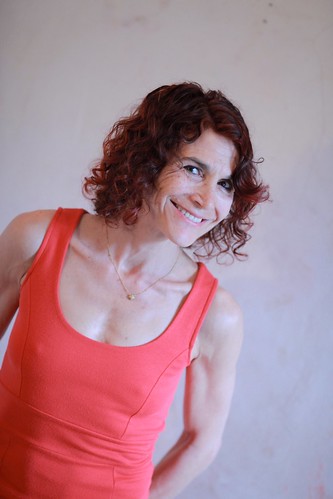 Paula CourtJody Oberfelder
Paula CourtJody OberfelderJody Oberfelder is an East Village dancer/choreographer who started out as the lead singer for the Bagdads, a punk band which played at CBGB’s. She then became a dancer and choreographer who has brought to both roles unusual athleticism, heart, humor, and in the words of Village Voice critic, Deborah Jowitt, “a zest for endearingly human dancing in an upside-down world.”
She has gone from creating works with titles such as “Wanted X Cheerleaders” and “Crash Helmet Brigade” to directing opera (“Dido and Aeneas”) and now Igor Stravinsky’s “The Soldier’s Tale,” which she will present at the Michael Schimmel Center for the Performing Arts at Pace University (where “Inside the Actors Studio” is filmed) from June 9 to 11. Recently The Local spoke to her about her work and how living in the East Village has influenced it.
Q.
You have been part of the East Village arts scene for a long time. How has living here informed your work as a dancer and choreographer?
A.
I’ve lived in the East Village from 1980 to the present, and I saw it change from a place where it was still full of old Ukrainian characters and really scary just to go east of Avenue A. When Life Café came into being on Avenue B, I remember kind of tip-toeing my way over there beside the park. I think I was just one of the many kinds of art-makers and filmmakers who was around at that time. Steve Buscemi and his wife Jo Andres were going to all the same events, and he’s pretty famous now! It was more of a cabaret-ish atmosphere, and you’d stay out pretty late, too. There was a great performance duo called Dancenoise, and also the “Full Moon” shows at P.S. 122. This was the more liquid East Village, more sweaty and physical. There were also people doing more esoteric work at the time.
Read more…
 Michelle Rick
Michelle RickGood morning, East Village.
While the city agrees on the proposal to expand the boundaries intended to preserve several East Village landmarks, Jeremiah’s Vanishing New York reports that a significant part of the neighborhood’s history has just been lost. The faded lettering for The Fat Black Pussycat Theatre, which hung over Panchito’s restaurant, was painted over by the owners on Wednesday. The fresh coating of paint not only obscures the daily reminder that the Minetta Street location was once much more than a restaurant, but also takes away those little moments of discovery that help residents who were unaware engender a healthy respect for the history that surrounds them.
Forgotten New York provides a very informative digital walking tour of St. Marks Place. The tour encompasses the full personality of the street, covering everything from the architectural, to the cultural, to the personal for history that is old, new, and sometimes, in the making.
And it didn’t take the Parks Department long. Today the ping-pong table in Tompkins Square Park will receive its first bath after being tagged — also a first — last weekend.
 Adrian Fussell
Adrian FussellA sampling of reader reactions to recent posts that have appeared on The Local.
Brendan Bernhard’s recent post on his ambivalence toward bicycles prompted a range of reactions.
Dave, who described himself as a “committed cyclist,” wrote:
“I don’t get the NYC vibe (which is not limited to pizza deliveryemen and bike messengers, by the way) that all bad behavior on a bike is excusable because ‘hey man, I’m riding a bike’. When car and bike meet, car almost always wins. When bike and pedestrian meet, bike can win but at a cost to the rider. Better that we should all be more mindful of the other. And the police should enforce the rules of the road, regardless of the means of conveyance.”
Jody Oberfelder said:
“Everybody should look out for everybody. Share the road!”
Read more…
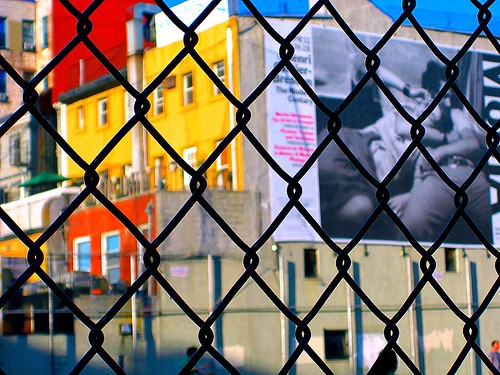 Michelle Rick
Michelle RickCities are unforgiving places, and New York perhaps the least forgiving of all.
One of its less attractive traits has always been its self-mythologizing triumphalism and I ♥ NY campaigns, a localized form of the nationalism it derides in the rest of the country. “If I can make it there, I’ll make it anywhere,” Frank Sinatra sang in what has become Manhattan’s unofficial national anthem and New Year’s rallying cry. It’s a sentiment to which countless scrambling citizens still subscribe. If they can just work hard enough, be ingenious and ruthless enough, they too will be “king of the hill / Top of the heap,” because this is the place. Or so we like to think.
Is it, though? Just over a century ago, C.P. Cavafy (1863-1933), an enduringly popular Greek poet who lived in Alexandria, Egypt, wrote a 16-line poem called “The City” which immortalizes a peculiarly urban dilemma whose outlines disenchanted New Yorkers will readily recognize. Those who have just moved here should read the poem, memorize it, print it out, and stick it on the fridge door.
Read more…
 Mario Ramirez
Mario RamirezGood morning, East Village.
Hope your Memorial Weekend was something to remember.
As we start the week, Neither More Nor Less reminds readers that not every Memorial Day in the East Village passed as peacefully and offers a recollection of the 1991 Memorial Day riot in Tompkins Square Park.
The park closed for a year, following the incident, in order to undergo a $2.3 million renovation project. For a full account of the story, visit The Times’ archives.
In other news, the Bowery has been credited as the birthplace of the ice-cream sandwich. In a recent Q&A, The Times referred to the book “Of Sugar and Snow: A History of Ice Cream Making” by Jeri Quinzio, which maintains that the popular summer treat was first made available through pushcart vendors peddling along the Bowery. The sandwiches were first sold for 3 cents apiece, a price that was subsequently driven down to one penny by New Yorkers. Go to the article for one paper’s intriguing description of how the sandwiches were made.
And finally, Neighborhoodr! captured mosaic artist Jim Powers making progress on his “Japanese tribute pole” on Second Avenue & St. Mark’s Place last Friday. With Japan’s economy already suffering massive blows from Fukushima and TEPCO officials recently admitting they see no end in sight for the reactor crisis, the country will continue to depend on international support.
This post has been changed to correct an error; an earlier version misstated the sequence of events leading up to the 1991 Memorial Day riot.
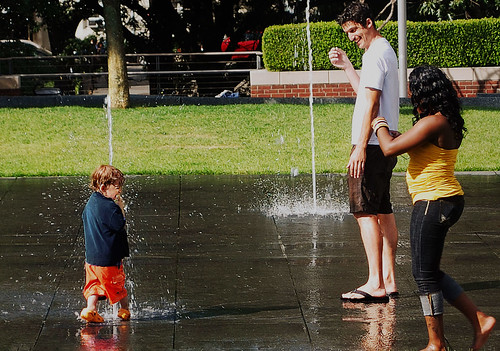 Rachel Citron
Rachel CitronGood morning, East Village.
And Happy Memorial Day.
Who needs to travel when so many cheap and interesting things are happening in your own backyard? This weekend the Theatre for New City hosted the Lower East Side Festival of the Arts for its 16th annual celebration. More than 100 artists participated in the event, offering live music, poetry, dance, and other performances — many for free — for what has turned out to be the latest contribution to a colorful tapestry.
For another look at art in the village check out Celine Danhier’s documentary “Blank City.” It offers retrospective on the birth of the East Village’s “No-budget” filmmaking industry — which should also be in quotes, seeing as all that was required to start out in those days was a camera and a willingness to shoot. The film revisits the work of those who were successful at it, and provides a look at the cultural dynamic of “No Wave” film; both in its heyday and as it evolved.
Also, it appears that the Landmarks Preservation Commission’s recent expansion of the study area for a proposed East Village Historic District could make the birthplace of drag a local landmark. DNAinfo reports that the site of the 1979 performance bar the Pyramid Club, where RuPaul was said to hone her craft, falls smack within the range of the broadened prevention effort.
Finally, two very different acts involving spray paint: while upcoming nuptials are celebrated on a mural on Avenue A and Second Street, the honeymoon is over for the ping pong table at Tompkins Square Park — someone has finally tagged it with graffiti.
Michael Sean Edwards on East Village life in the 1970’s and 80’s.
“One of the things that most struck me about the East Village when I moved here in 1978, and what made me love it so much is that it really was a village; an enclave in NYC that felt like old Europe rubbing up against the new wave.”
Read more…
 Grace Maalouf Tomorrow’s UEFA Champion’s League Final between Barcelona and Manchester United is certain to intensify the rivalries among the East Village’s European soccer fans. Above, Manchester United fans take in a match at Nevada Smith’s earlier this year. Below: Barcelona memorabilia at Nevada’s.
Grace Maalouf Tomorrow’s UEFA Champion’s League Final between Barcelona and Manchester United is certain to intensify the rivalries among the East Village’s European soccer fans. Above, Manchester United fans take in a match at Nevada Smith’s earlier this year. Below: Barcelona memorabilia at Nevada’s.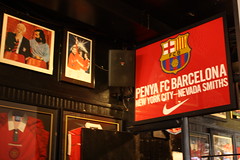 Kenan Christiansen
Kenan ChristiansenSaturday will be a big day in the East Village, which, as you may have noticed, has a lot of Europeans living in it, visiting it, and — East Village merchants say Thank You! — spending a lot of much-needed money in it.
Tomorrow afternoon, however, many of those Europeans will be passionately engaged in watching the UEFA Champion’s League Final between Barcelona and Manchester United, which starts at 2:45 p.m. and is being shown live on Fox. (Not Fox’s soccer channel, but its main channel — i.e., the one that shows “American Idol.”) However, expect many of them to be watching in bars and restaurants around the East Village and Lower East Side, including Nevada Smith’s, The Central Bar, etc. As will be plenty of other New Yorkers from around the world, including a healthy dose of native New Yorkers.
Now for the match itself. What have we got?
Read more…
Ladies of the East Village, it’s time to stash your stilettos away and save your flip flops for the beach. This season is all about chunky heels, whether they are giving some lift to a pair of gladiators or height to your favorite strappy sandals. On the street, the wedge is a walking shoe with the height of high heels and all the glitz too. It’s sure to be seen as summer rolls around.
NYU Journalism’s Rachel Ohm reports.
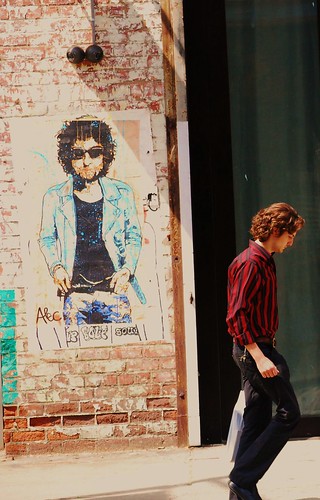 Tim Schreier
Tim SchreierToday we begin a recurring series of interviews with local experts who will offer their takes on cultural issues, trivia questions and current events concerning the neighborhood.
On Tuesday, American songwriting legend Bob Dylan celebrated his 70th birthday.
In a career that’s spanned 40 years and has had more than its share of mystery, one of the most enduring questions concerns Dylan’s disposition toward the Village and the meaning of the song, “Positively 4th Street.”
Some say the song was meant as a rebuke of all the plastic folkies Dylan met while living in the Village, while others claim it was Dylan’s way reacting to being booed, after leaving his fan-base to go electric at the Newport Folk Festival in 1965, and still others say Dylan was merely talking about the “many 4th streets of his life.” In any case, the song provoked a widespread feeling of individual unease by directing it’s accusations toward a universal “you:”
“You got a lotta nerve
To say you are my friend
When I was down
You just stood there grinning”
The Local East Village contacted Jeff Conklin, co-content Director for East Village Radio to provide his take on the song and Dylan’s relationship to the East Village.
Q.
What’s your interpretation of the song “Positively 4th Street?”
A.
Quite simply jealousy. The song reminds me of a bucket full of crabs, where one crab is inching to get out and all the other crabs are trying to pull him back down. That’s my example of what happened to Dylan, anyway.
“You got a lotta nerve
To say you got a helping hand to lend
You just want to be on
The side that’s winning.”
He had to be angry when he wrote it. It’s a great song.
Read more…
Earlier this week, we told you about plans to expand the boundaries of the proposed historic district for the East Village; under the proposal the number of buildings receiving landmark protection would grow to 287 from 270. We’ve just learned that the Landmarks Preservation Commission will vote June 28 regarding whether to hold a public hearing about the creation of the district; a commission spokeswoman told us that the final vote to determine whether the buildings are landmarked will likely not be held this summer. Check The Local often as we continue to follow developments in this story.—Stephen Rex Brown
A would-be message from the East Village, in 140 characters or less and inspired by photography.
 Brendan Bernhard
Brendan BernhardPansies at Night (E. 9th St.)
Angry old men is what they look like, with eyes
like eyebrows and in-your-face mustaches. Purple
quiffs! Yellow noses! From drinking what?
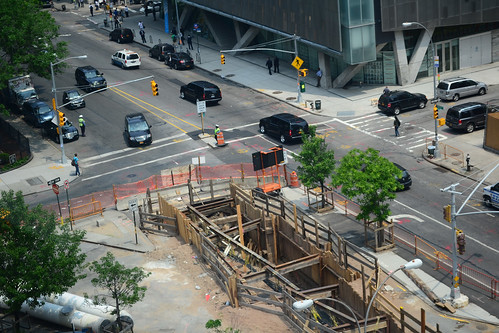 Kyle Terwillegar After initially announcing that a water main project in Cooper Square would be finished by the winter, city officials now say it won’t be completed until spring 2012 at the earliest.
Kyle Terwillegar After initially announcing that a water main project in Cooper Square would be finished by the winter, city officials now say it won’t be completed until spring 2012 at the earliest.If you’ve walked around Cooper Square for the past few weeks, you’ve probably seen how it’s been turned into a labyrinth of construction barricades and detoured traffic due to the replacement of water mains in the area.
Well, the excavation overtaking much of the intersection of the Bowery and Fourth Avenue will not be finished anytime soon. After originally announcing that the project would be finished this winter, officials now say that the work won’t be completed until spring 2012 at the earliest.
Ray Martin, the operating engineer at the site, which stretches from Cooper Square to East Fourth Street, said on Thursday that the work wouldn’t be finished until summer of next year.
“The timeline changes all the time, there’s a lot of utilities in the ground,” Martin said.
A spokesman for the Department of Design and Construction, Craig Chin, took a more optimistic view, saying that work could be completed by spring 2012. But he did not dispute that the $10.8 million job, which involves replacing antiquated water mains up to Astor Place, is a tough one.
“If you look at the open trench, it’s a tangled web of wires,” Mr. Chin said. “Things have to be moved from one side to the other so they can put in water mains. It’s a painstaking process.”
Kyle Terwillegar contributed information to this post.
 Michelle Rick
Michelle RickGood morning, East Village.
The trial of two East Village officers accused of raping a woman concluded yesterday after almost two months of testimony. Officers Kenneth Moreno and Franklin Mata, formerly of the Ninth Precinct, were acquitted of rape charges but convicted on three counts of official misconduct; all other charges were dismissed. According to DNAinfo, the officers will lose their jobs as a result of the convictions and could face up to two years in jail. However, some members of the community are bemoaning the verdict, declaring that the officers’ acquittal on more serious charges damages the credibility of the police and could prevent rape victims from coming forward in the future.
During a speech in Cooper Union yesterday, Mayor Bloomberg cautioned opponents of same-sex marriage not to be on the wrong side of history. In his speech, he likened the struggle for marriage equality to several other historical civil rights movements and called for a vote on the issue in the current legislative session, rather than waiting until 2012, citing that as the birthplace of the gay rights’ movement, New York had a duty to lead. DNAinfo has the story.
And finally, after 20 years as the host of Moorish Orthodox Radio Crusade on WBAI-FM 99.5, Bill Weinberg was let go from the self-described “Free Speech Radio” station in March for “denigrating other programmers on the airwaves.” Mr. Weinberg claims his departure came after he began openly criticizing the radio station’s support of right-wing commentators and conspiracy theorists. For more on the story head to the City Room blog at The Times.
A day after preservationists held a vigil for the demolished 35 Cooper Square, The Local takes a look back at the historic building with archival photographs provided by David Mulkins of the Bowery Alliance of Neighbors, one of the leaders of the campaign to maintain the building.
Read more…



